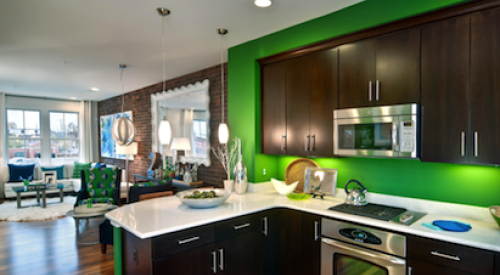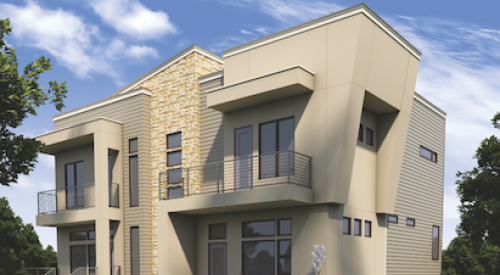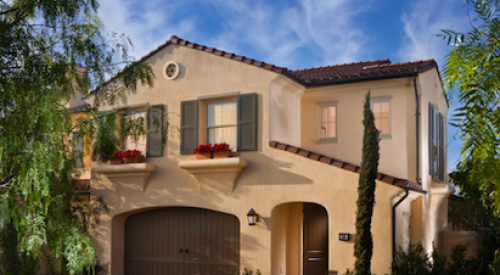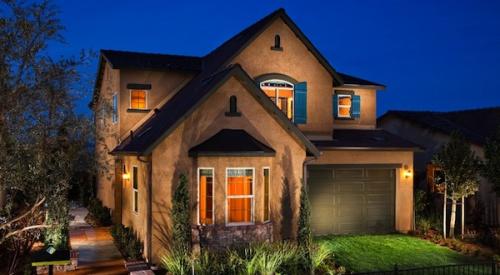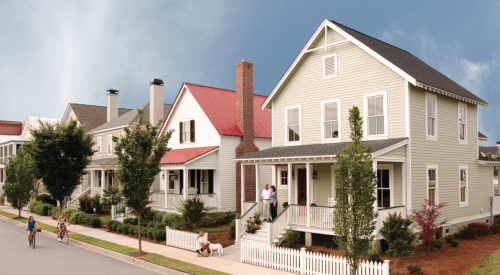A drive through South Phoenix, Ariz., 10 years ago might not have been a fun ride. Substandard houses and poorly maintained properties outnumbered well-kept, attractive homes in a quasi-rural atmosphere dotted with citrus groves and small farms.
The city wants to - and is succeeding in - creating a different picture, with help from resident committees, planners, and commercial and residential developers. Great Western Homes, one of the home-building pioneers of the area, and its Ridgefield community contribute to the changing face of the area.
|
The Galloway Group, based in Newport Beach, Calif., took cues from historical styles to craft Ridgefield's elevations. A variety of forms, roof pitches and materials break up the two-story forms and 35-foot widths that the density (more than nine to the acre) required. On the smallest of the homes, the 1,315-foot Andria (above), a whimsical, framed and stuccoed, second-story window detail helps draw the eye up, away from the garage door. Varied roof lines give the elevation even more movement.
|
|||||||||
|
The Treviso (below) downplays the garage with house-forward design. The second floor cantilevers over the single-car garage, creating a porte-cochere effect.
The 1,600-square-foot Trevison plan features an open family zone at the rear and a more formal space up front. See the Trevison floorplan |
|||||||||
|
|
|
|
|
The arched, recessed windows of the Verona feature a sloped sill, which has been painted a slightly different shade than the rest of the home to make it look richer, architect Terry Galloway says.
Opportunities
Ten years ago the city of Phoenix divided South Phoenix into 15 urban villages, each with its own staff planner and growth plan that aims to offer a variety of housing, job opportunities, education, recreation and shopping facilities. The Salt River to the north; South Mountain Park, a large municipal space to the south; and 48th St. and 27th Ave. on the east and west, respectively, define the area known as South Mountain Village. The location - 10 minutes to the heart of downtown, job corridors, Arizona State University and sports venues such as the America West Arena - makes it prime for redevelopment.
"Scott Smith, our president, began working with community and civic leaders about five years ago to bring new housing to the area," says Jim Gifford, vice president of operations for Great Western. "Their combined vision of 'what could and should be' helped start the revitalization of this historic part of Phoenix. Ridgefield is now our seventh community in the area."
Civic responsibility and housing affordability matter to Great Western Homes, but its motives were not purely altruistic: The ongoing redevelopment of South Mountain Village opens up new infill land positions and a new market of underserved potential buyers seeking a better home within their existing neighborhood. Great Western's early participation, responsiveness to the city's goals and buyers' needs, and willingness to take risks on land and innovative products created goodwill and encouraged speedy approvals of future communities, says Preston John, broker and president of Larry John Wright Real Estate, a real estate marketing and advertising firm.
Obstacles
Along with great opportunity came some challenges. In 2001, Great Western started working with the city and the Galloway Group, a planning and architecture firm from Newport Beach, Calif. To keep the single-family home community affordable meant the company needed to create entirely new, smaller floor plans and, as Terry Galloway says, apply attached planning thinking to detached homes. That meant designing two-story homes (in a ranch-dominant market) and putting them on the smallest lots in Great Western's history.
The 181 homes sit on 40x48-foot lots, or just 1,920 square feet of ground. Their side and back yards of just 3 to 4 feet offer little outdoor space. Sales associate Claudia Schulz admits the small yards concerned her most - she thought that the Ridgefield bedroom counts of two to four bedrooms would mean kids, and kids need room to play, she says.
As it turns out, few Ridgefield buyers have kids, though the Galloway Group prepared for the possibility nonetheless. A density of 9.4 units to the acre allowed for 15 percent open space, three times what the city of Phoenix required. To make it attractive and useable, Galloway centrally located a tot lot with dedicated parking, rather than just putting playground equipment in a retention basin, as often happens when builders aren't willing to sacrifice choice land, he says.
Galloway wondered how another new home anomaly in the Phoenix market - the one-car garage - would sell. "We thought people with two cars wouldn't like the product and would buy elsewhere," says Galloway.
Schulz says some potential buyers voiced concerns, wanting to know if an option for a second garage existed. "I told them no." she says. "Keeping the lots small keeps the price low." That rationale, coupled with long driveways that provide parking space for a second car, narrower curb cuts that allow for additional street parking, and planned community parking areas countered most objections. (Still, Schulz notes, the Ridgefield plans have been altered to include two-car garage options for subsequent South Mountain Village communities.)
For all involved, the salability of such small homes caused concern. Those concerns were unfounded. To most buyers - 80 percent of whom were first-time buyers coming largely from apartments - Ridgefield offered the same or more space than before, not less. Ridgefield buyers were not square-footage buyers, partly because they didn't need a lot of space.
"When you move from an apartment to a single-family home, your legs don't get longer," Galloway says.
In addition to sales obstacles, Ridgefield posed construction challenges in the beginning. Great Western managed the high volume of building and limited construction access to the houses because of tight conditions through carefully managed phase releases.
Outcomes
Ridgefield sold all 181 units within 12 months of opening presales, and increased its prices from its initial $89,990 to $99,990 to a range of $110,490 to $121,490 - without hurting affordability. At under $120,000, it still offered good value and something many buyers - 50 percent to 60 percent of whom came from the surrounding South Phoenix area - thought they'd never have: a home of their own.
Its buyer mix reflects the diversity of the area - 25 percent Hispanic, 50 percent African-American and 25 percent white, according to John. Bilingual signs and marketing materials and the sales staffs' nametags that read "Hablo Espa±ol," made the buying process easier for those more comfortable with Spanish than English. (Great Western tries to place a Spanish-speaking agent in every community.)
"We like working with first-time buyers," Shulz says. "They get attached to you. You become more of a mentor through the home-buying experience than just a sales associate." She says she and other sales associates were routinely invited to homeowners' housewarming parties and barbeques. Yes, there is enough room for a (small) outdoor gathering, she says.
"Our goal was to cater to a market that couldn't otherwise afford a house," Shulz adds. And make money doing it. Both missions accomplished.

